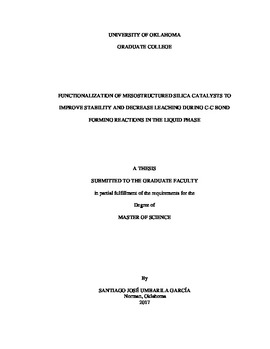| dc.description.abstract | The ordered mesoporous silica materials such as MCM-41 and SBA-15 have raised special attention because of its chemical and thermal stability. Several studies have been reported the ubiquitous modification method of the silica surface through conventional conventional grafting (CG) and co-condensation (CC) functionalization 1–6. The CG modifies the surface of the silica through sylilation process of the free surface-silanols with organosilanes. On the other hand, the CC method uses the TEOS as the building block for silica structure in the one-pot mixture with organosilanes as functional moieties. The resulting hybrid materials has mesoporous hexagonal structure together with organic functional groups anchoring on the surface.
It has been reported that the created Si-O bonds obtained from conventional functionalization process are thermally stable, mostly in mild conditions, which in turn prevents the loss of those active moieties via the leaching or decomposition. Nevertheless, there are a few works reporting the leaching phenomena happened in more severe chemical conditions in either non-polar or polar solvents. The lack of comprehensive examination, as well as plausible solutions, for the leaching problem in the literature limits the application of the materials for many harsh chemical processes. Therefore, in this study, the fundamentals behind the leaching phenomenon will be investigated at the molecular level by utilizing advanced techniques comprising Fourier-Transform Infrared Spectroscopy (IR), Transmission Electron Microscopy (TEM), Solid-State Nuclear Magnetic Resonance (NMR) of 29Si, 1H and cross polarization 1H-29Si, X-ray Diffraction (XRD).
In this study, a new synthesis method, called dry-grafting method, will be proposed to provide a novel and simple way to synthesize stable non-leaching catalysts for acid-catalyzed reaction, even under severe conditions (polar solvents, high temperature, etc). The catalytic stability is examined by the alkylation between cyclopentanol (CPOL) and m-cresol as a model compound reaction, which is practically relevant to biomass conversion into chemicals and alternative transportation fuels. | en_US |
